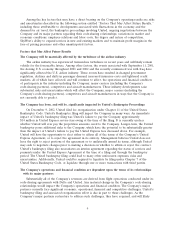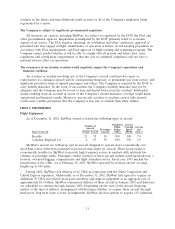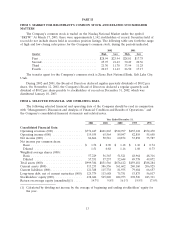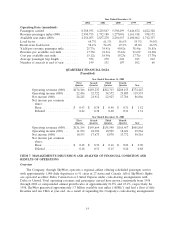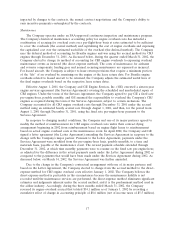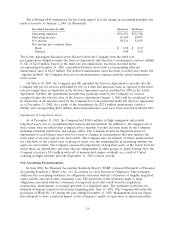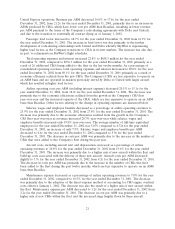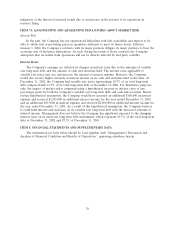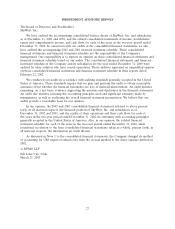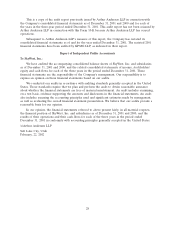SkyWest Airlines 2002 Annual Report Download - page 23
Download and view the complete annual report
Please find page 23 of the 2002 SkyWest Airlines annual report below. You can navigate through the pages in the report by either clicking on the pages listed below, or by using the keyword search tool below to find specific information within the annual report.In August 2001, the FASB issued SFAS No. 144, Accounting for the Impairment or Disposal of
Long-Lived Assets. This statement supercedes SFAS No. 121, Accounting for the Impairment of
Long-Lived Assets and for Long-Lived Assets to be Disposed Of, and the accounting and reporting
provisions of Accounting Principles Board (‘‘APB’’) Opinion No. 30, Reporting Results of Operations—
Reporting the Effects of Disposal of a Segment of a Business, and Extraordinary, Unusual and Infrequently
Occurring Events and Transactions. SFAS No. 144 requires that the same accounting model be used for
long-lived assets to be disposed of by sale, whether previously held and used or newly acquired, and it
broadens the presentation of discontinued operations to include more disposal transactions. The
Company adopted the provisions of SFAS No. 144 on January 1, 2002, which did not have an impact
on the Company’s results of operations or financial position.
In April 2002, the FASB issued SFAS No. 145, Rescission of FASB Statements No. 4, 44, and 64,
Amendment of FASB Statement No. 13, and Technical Corrections. SFAS No. 145 states that gains and
losses from extinguishment of debt that do not meet the criteria for classification as extraordinary items
in APB Opinion No. 30, should not be classified as extraordinary items. Accordingly, SFAS No. 145
rescinds SFAS No. 4, Reporting Gains and Losses from Extinguishment of Debt, and SFAS No. 64,
Extinguishments of Debt Made to Satisfy Sinking-Fund Requirements. SFAS No. 145 is effective for the
Company on January 1, 2003 and is not expected to have a material impact on the Company’s results
of operations or financial position.
In June 2002, the FASB issued SFAS No. 146, Accounting for Costs Associated with Exit or Disposal
Activities. This statement applies to costs associated with an exit activity, including restructuring
activities, or with the disposal of long-lived assets. Exit activities can include eliminating or reducing
product lines, terminating employees and related contracts, and relocating plant facilities or personnel.
Under the provisions of SFAS No. 146, entities will be required to record a liability for a cost
associated with an exit or disposal activity when that liability is incurred and can be measured at fair
value. The provisions of SFAS No. 146 are effective for exit activities initiated after December 31, 2002.
Management does not expect that the adoption of this statement will have a material impact upon the
Company’s results of operations or financial position.
In November 2002, the FASB released FASB Interpretation No. 45 (‘‘FIN 45’’), Guarantor’s
Accounting and Disclosure Requirements for Guarantees, Including Indirect Guarantees of Indebtedness of
Others: an interpretation of FASB Statements No. 5, 57, and 107 and rescission of FASB Interpretation
No. 34. FIN 45 establishes new disclosure and liability-recognition requirements for direct and indirect
debt guarantees with specified characteristics. The initial measurement and recognition requirements of
FIN 45 are effective prospectively for guarantees issued or modified after December 31, 2002.
However, the disclosure requirements are effective for interim and annual financial-statement periods
ending after December 15, 2002. The Company adopted the disclosure requirements of FIN 45 for the
year ended December 31, 2002 and will be required to adopt the measurement and recognition
provisions of FIN 45 in the first quarter of 2003. Management of the Company does not expect the
adoption of the measurement and recognition provisions of FIN 45 to have a material impact on the
Company’s results of operations or financial position.
In December 2002, the FASB issued SFAS No. 148, Accounting for Stock-Based Compensation—
Transition and Disclosure—an amendment of FASB Statement No. 123, SFAS No. 148 is effective for
fiscal years beginning after December 15, 2002 and amends SFAS No. 123, Accounting for Stock-Based
Compensation, to provide alternative methods of transition for a voluntary change to the fair value
based method of accounting for stock-based employee compensation. In addition, SFAS No. 148
amends the disclosure requirements of SFAS No. 123 to require prominent disclosures in both annual
and interim financial statements about the method of accounting for stock-based employee
compensation and the effect of the method used on reported results. The Company adopted SFAS
No. 148 as of December 31, 2002. The effect of the adoption of this statement was not material as the
Company continues to use the intrinsic value method allowed under SFAS No. 123.
19


